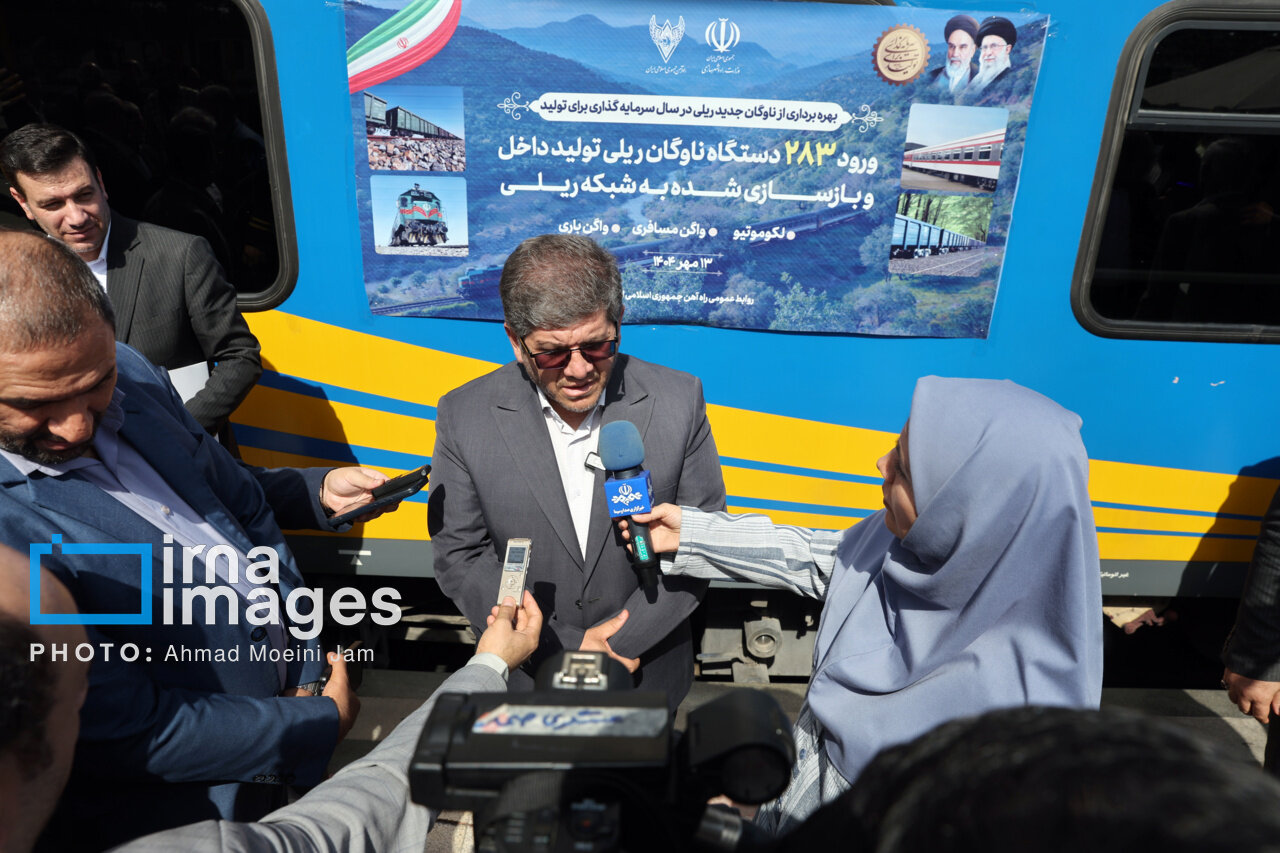New railway financing models to be unveiled in presence of transport, economy ministers

TEHRAN- The head of Iranian Railways stated: “In order to provide financial resources for companies active in the railway sector, new financing models will soon be unveiled at an event attended by the Ministers of Transport and Economy.”
Jabbar Ali Zakeri said on Sunday, on the sidelines of the ceremony for the inauguration and operation of 17 rail projects and the entry of 283 domestically produced and rebuilt rail fleets into the country's railway network, to reporters: “The quantitative target of the Seventh National Development Plan is to increase the current approximate nine percent share of rail freight to 30 percent by the end of the plan.”
He stated: “We hope that the required investment will be largely provided by the private sector.”
The official, who is also the deputy minister of transport, further noted: The memoranda of understanding signed so far between the Railway and the private sector is certainly not enough”, and continued: “In the near future, we plan to hold two investment events. The first one involves using Article 12 of the Law on Removing Production Barriers.”
Explaining the second event, Zakeri noted: “We are seeking to facilitate resource provision for companies, and in this regard, various models have been envisaged. For this purpose, another event will be held in Aban (the eighth month of the Iranian calendar, approximately October-November) with the presence of the Minister of Transport and Urban Development, the Minister of Economy, and the members of the Economic Committee of the Parliament, during which financing models will be unveiled.”
He said: So far, two phases of fuel consumption saving subsidies from the Oil Ministry have been implemented, and the third payment phase from this source will be unveiled with the participation of companies in about two to three weeks.
The Railway head also stated: “Currently, facility payments are planned from three sources: Note 18 of the Budget Law, Article 12 of the Law on Removing Production Barriers, and also the National Development Fund. New financing methods will be announced within the next month.”
Iran inaugurated 17 rail infrastructure projects and added 283 domestically manufactured and rebuilt rolling stock units to its railway fleet in a ceremony held via video conference with President Masoud Pezeshkian and Transport Minister Farzaneh Sadegh.
The projects, valued at 90 trillion rials (about $180 million), were unveiled in the presence of the head of the Islamic Republic of Iran Railways and industry operators.
The new additions include 224 freight wagons built domestically, 14 new and rebuilt locomotives, and 45 new and rebuilt passenger coaches.
Infrastructure projects inaugurated at the same ceremony include the construction of 50 kilometers of double track on the Bafq–Zarrin Shahr line in central Iran, track and turnout rehabilitation on the Karun–Miandasht block in the south, and upgrades to signaling systems at several stations, including Rahgard in the Arak region.
Other initiatives involved fitting shunting locomotives with video monitoring systems, building a spur line for Shirin Asal Company in East Azarbaijan, and expanding capacity at Nezamieh station in Khuzestan Province.
The ceremony was held in conjunction with a broader set of Ministry of Transport inaugurations commemorating Iranian casualties of the recent 12-day Israeli attack. In total, the ministry inaugurated 57,226 housing units and 202 transport, urban development, and meteorology projects worth 1.640 quadrillion rials ($32.8 billion) and $125 million.
Also, two Iranian companies signed investment contracts worth 145 trillion rials (about $290 million) to modernize and build railway rolling stock, in a deal signed in the presence of Transport and Urban Development Minister Farzaneh Sadegh and the head of Iran Railways, Jabbar-Ali Zakari.
The investment aims to upgrade the country’s rail transport capacity, support domestic manufacturing, and reduce reliance on imports.
Under the agreements, one company will allocate 120 trillion rials ($240 million) to the construction and overhaul of 40 heavy locomotives, 37 passenger locomotives and four Siemens locomotive engines. The second company will invest 25 trillion rials (about $50 million) to refurbish 50 passenger coaches.
Officials said the program is part of Iran Railways’ broader strategy to increase rail’s share in freight and passenger transport while strengthening local production capabilities.
The investment comes amid a wave of private-sector collaboration across the rail sector. In April 2025, Iran signed $750 million in memoranda with private firms to expand both its passenger and freight capabilities. One deal targets 600 tank wagons, 300 DMU cars and 50 locomotives, while another involves 650 bulk wagons.
More recently, in July, Iran’s Railways signed a $176 million agreement to upgrade passenger rolling stock, including the purchase of new “five-star Royal” cars and refurbishment of existing wagons with Raja Rail and Rail Tarabar Saba.
These investments align with Iran’s broader ambitions to scale up rail transit. The country aims to carry 8.0 million tons of goods via rail transit this year, up from 5.0 million tons last year, and ultimately boost annual transit capacity to 40 million tons.
If fully realized, the $290 million investment will become a lynchpin in an emerging ecosystem of public–private synergy in Iran’s rail sector — one that leverages indigenous manufacturing, reduces foreign dependencies, and helps meet the ambitious goals of the Seventh Development Plan.
MA
Leave a Comment